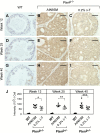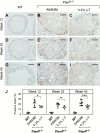δ-Tocopherol inhibits the development of prostate adenocarcinoma in prostate specific Pten-/- mice
- PMID: 29121168
- PMCID: PMC5862254
- DOI: 10.1093/carcin/bgx128
δ-Tocopherol inhibits the development of prostate adenocarcinoma in prostate specific Pten-/- mice
Abstract
The PTEN/PI3K/AKT axis plays a critical role in regulating cell growth, differentiation and survival. Activation of this signaling pathway is frequently found in human cancers. Our previous studies demonstrated that δ-tocopherol (δ-T) attenuates the activation of AKT by growth factor in prostate cancer cell lines, leading to inhibition of proliferation and induction of apoptosis. Herein, we investigated whether δ-T inhibits the development of prostate adenocarcinoma in prostate-specific Pten-/- (Ptenp-/-) mice in which the activation of AKT is the major driving force for tumorigenesis. By feeding Ptenp-/- mice with AIN93M or 0.2% δ-T supplemented diet starting at the age of 6 or 12 weeks, we found that δ-T treatment reduced prostate adenocarcinoma multiplicity at the age of 40 weeks by 53.3 and 42.7%, respectively. Immunohistochemical (IHC) analysis demonstrated that the phosphorylation of AKT (T308) was reduced in the prostate of the mice administered the δ-T diet. Consistently, proliferation was reduced and apoptosis was increased in prostate lesions of mice on the δ-T diet. Oxidative stress, as determined by IHC staining of 8-OH-dG, was not altered during prostate tumorigenesis, nor was it affected by administration of δ-T. In contrast, α-tocopherol (α-T) at 0.2% in the diet did not affect prostate adenocarcinoma multiplicity in the Ptenp-/- mice. This finding is consistent with data from our previous study that δ-T, but not α-T, inhibits the activation of AKT and the growth of prostate cancer cells. Together, these results demonstrate that δ-T inhibits the development of prostate adenocarcinoma in Ptenp-/- mice, mainly through inhibition of AKT activation.
© The Author(s) 2017. Published by Oxford University Press. All rights reserved. For Permissions, please email: journals.permissions@oup.com.
Figures






Similar articles
-
δ-Tocopherol inhibits receptor tyrosine kinase-induced AKT activation in prostate cancer cells.Mol Carcinog. 2016 Nov;55(11):1728-1738. doi: 10.1002/mc.22422. Epub 2015 Oct 14. Mol Carcinog. 2016. PMID: 26465359
-
Depletion of SAG/RBX2 E3 ubiquitin ligase suppresses prostate tumorigenesis via inactivation of the PI3K/AKT/mTOR axis.Mol Cancer. 2016 Dec 12;15(1):81. doi: 10.1186/s12943-016-0567-6. Mol Cancer. 2016. PMID: 27955654 Free PMC article.
-
δ-Tocotrienol is the Most Potent Vitamin E Form in Inhibiting Prostate Cancer Cell Growth and Inhibits Prostate Carcinogenesis in Ptenp-/- Mice.Cancer Prev Res (Phila). 2022 Apr 1;15(4):233-245. doi: 10.1158/1940-6207.CAPR-21-0508. Cancer Prev Res (Phila). 2022. PMID: 35144931 Free PMC article.
-
Interplay Among PI3K/AKT, PTEN/FOXO and AR Signaling in Prostate Cancer.Adv Exp Med Biol. 2019;1210:319-331. doi: 10.1007/978-3-030-32656-2_14. Adv Exp Med Biol. 2019. PMID: 31900915 Review.
-
PTEN, more than the AKT pathway.Carcinogenesis. 2007 Jul;28(7):1379-86. doi: 10.1093/carcin/bgm052. Epub 2007 Mar 6. Carcinogenesis. 2007. PMID: 17341655 Review.
Cited by
-
Selected Seeds as Sources of Bioactive Compounds with Diverse Biological Activities.Nutrients. 2022 Dec 30;15(1):187. doi: 10.3390/nu15010187. Nutrients. 2022. PMID: 36615843 Free PMC article. Review.
-
Role of Vitamins in Therapeutic and Targeting Approaches for Prostate Cancer: An Overview.Curr Drug Targets. 2024;25(14):934-952. doi: 10.2174/0113894501314558240822082557. Curr Drug Targets. 2024. PMID: 39257155 Review.
-
Secondary Metabolites of Fomitopsis betulina: Chemical Structures, Biological Activity and Application Prospects.J Fungi (Basel). 2024 Aug 29;10(9):616. doi: 10.3390/jof10090616. J Fungi (Basel). 2024. PMID: 39330376 Free PMC article. Review.
-
Vitamin E beyond Its Antioxidant Label.Antioxidants (Basel). 2021 Apr 21;10(5):634. doi: 10.3390/antiox10050634. Antioxidants (Basel). 2021. PMID: 33919211 Free PMC article. Review.
-
Plasma, Prostate and Urine Levels of Tocopherols and Metabolites in Men after Supplementation with a γ-Tocopherol-Rich Vitamin E Mixture.Nutr Cancer. 2021;73(11-12):2740-2750. doi: 10.1080/01635581.2020.1857412. Epub 2020 Dec 15. Nutr Cancer. 2021. PMID: 33319628 Free PMC article. Clinical Trial.
References
-
- Eitenmiller R.R., et al. (2005)Vitamin E: Food Chemistry, Composition, and Analysis. CRC Press, Marcel Dekker, Inc., New York, NY.
-
- Patel A., et al. (2007)Vitamin E chemistry. Nitration of non-alpha-tocopherols: products and mechanistic considerations. J. Org. Chem., 72, 6504–6512. - PubMed
Publication types
MeSH terms
Substances
Grants and funding
LinkOut - more resources
Full Text Sources
Other Literature Sources
Medical
Molecular Biology Databases
Research Materials

